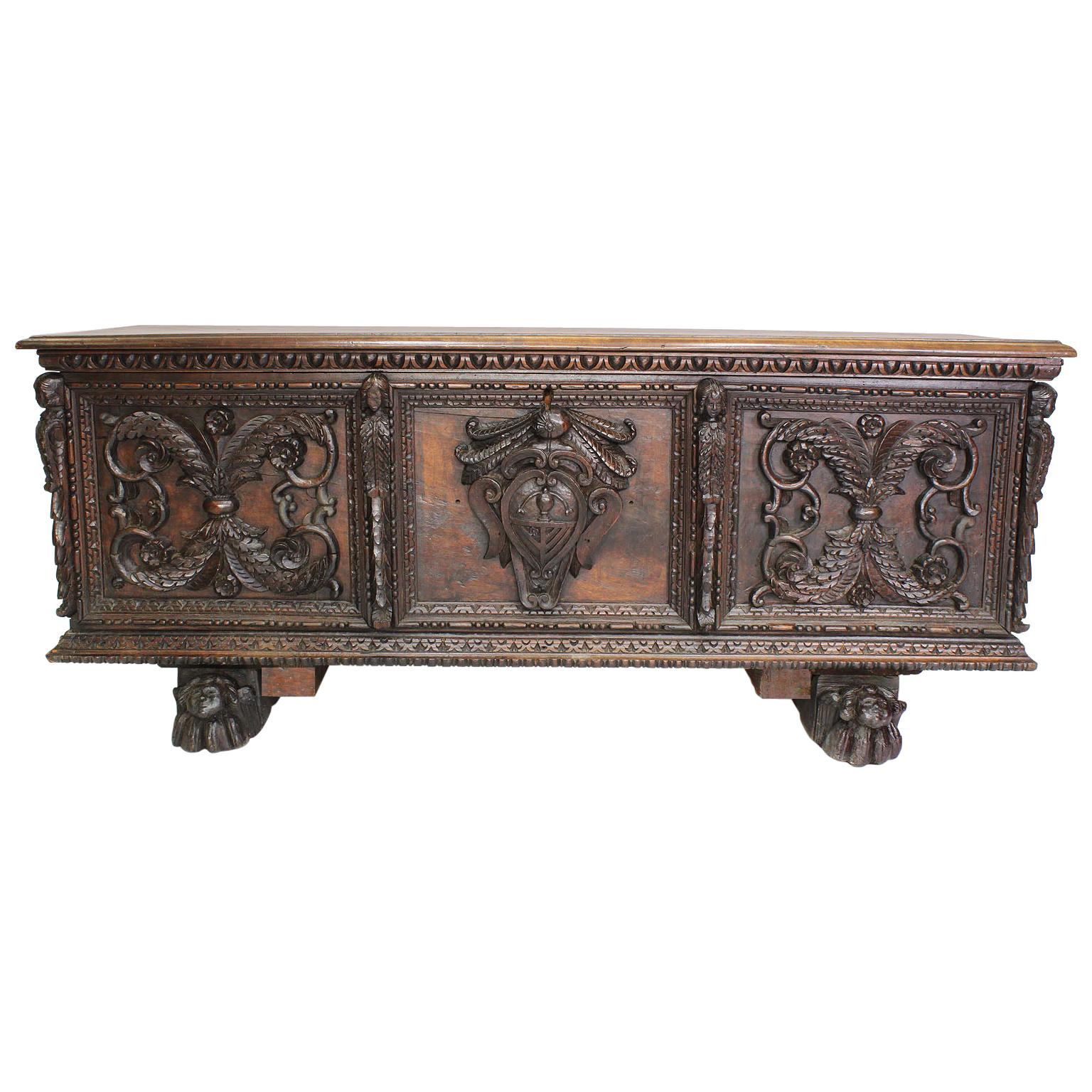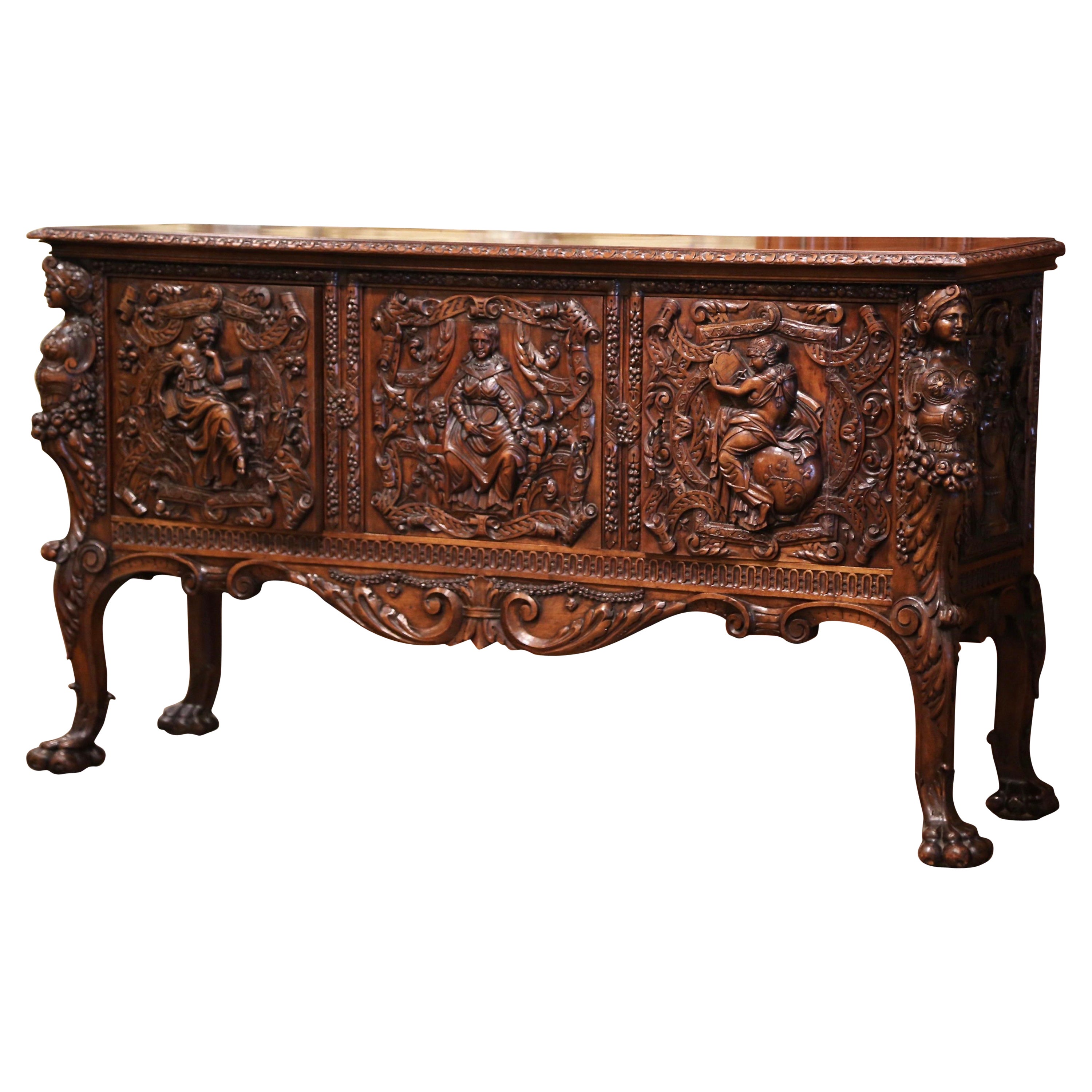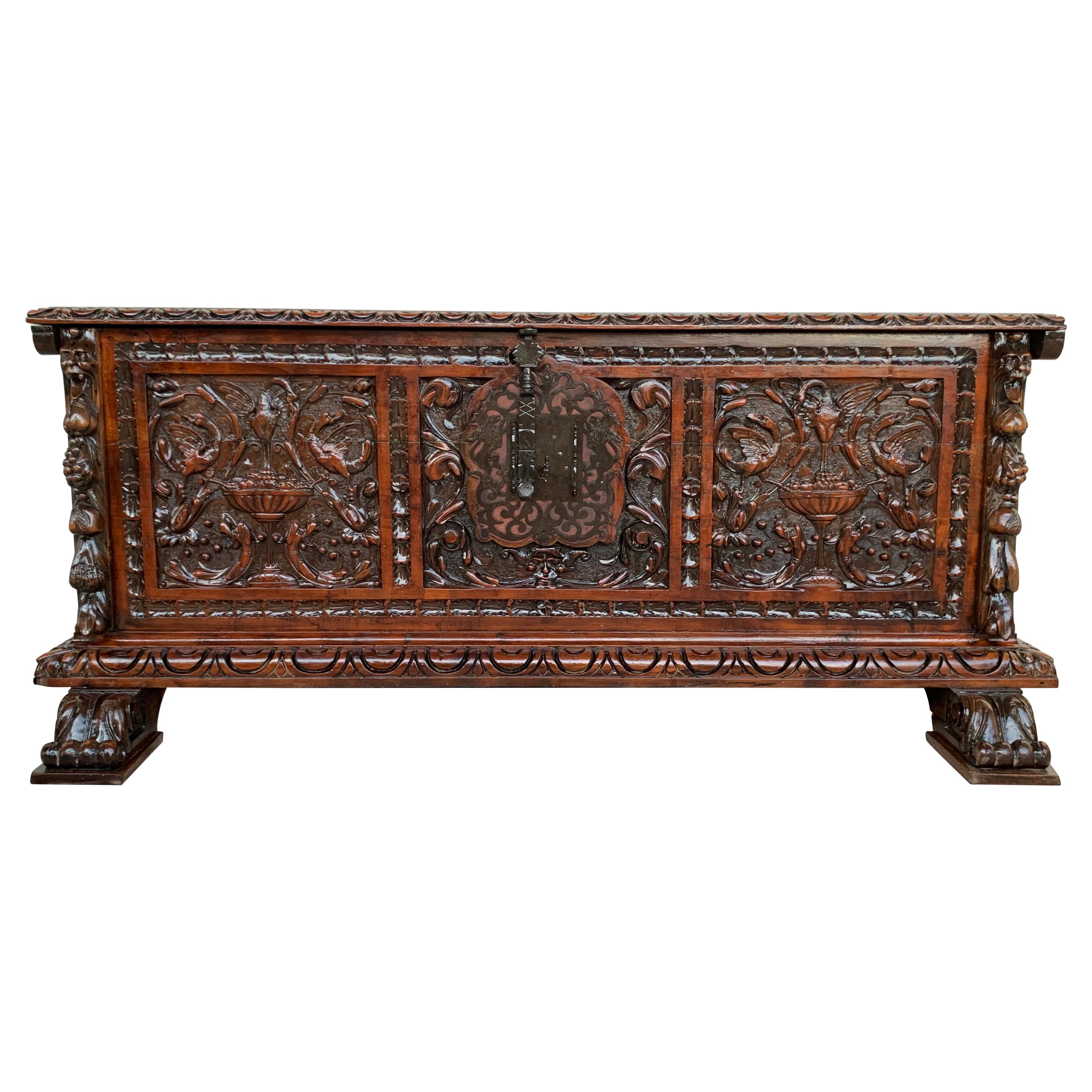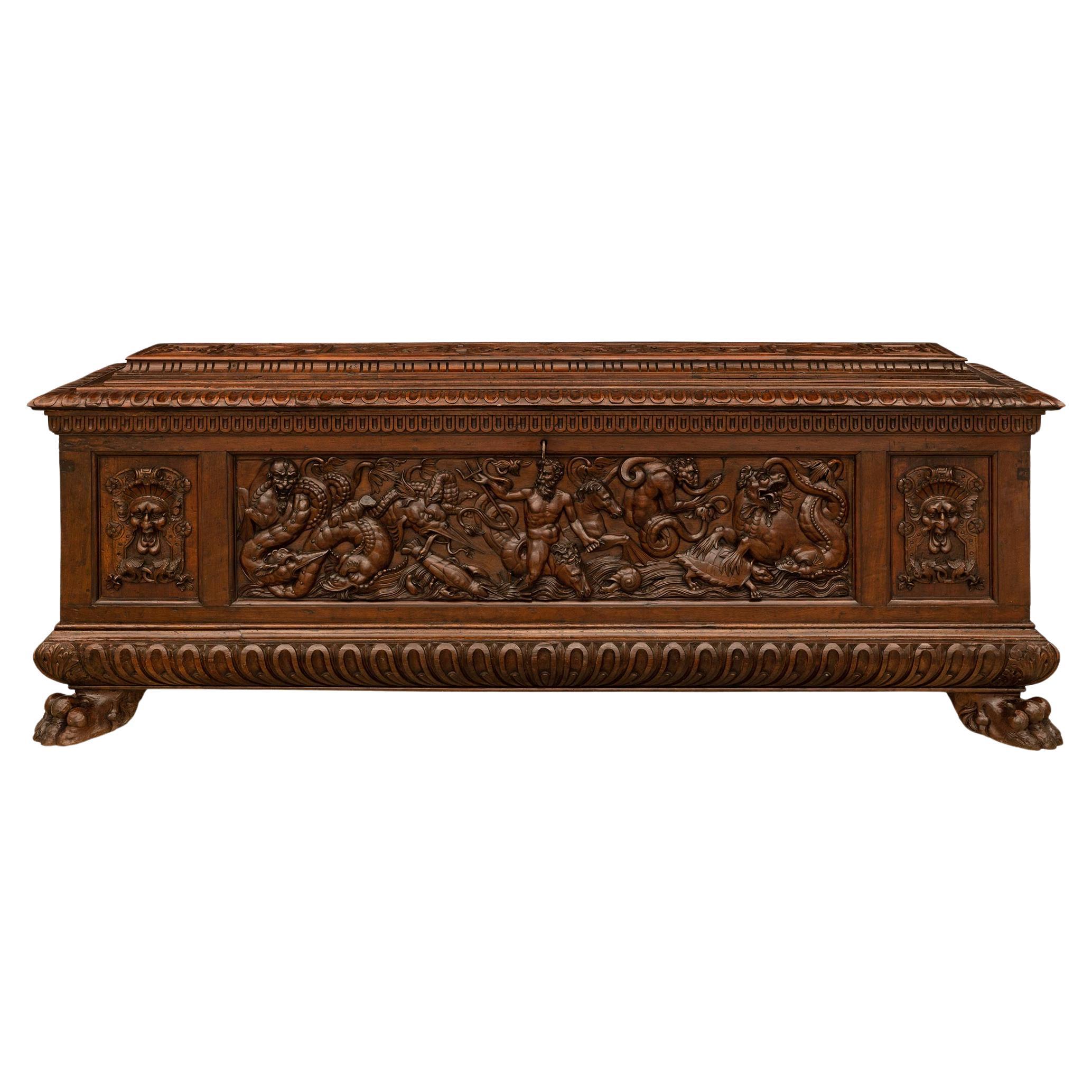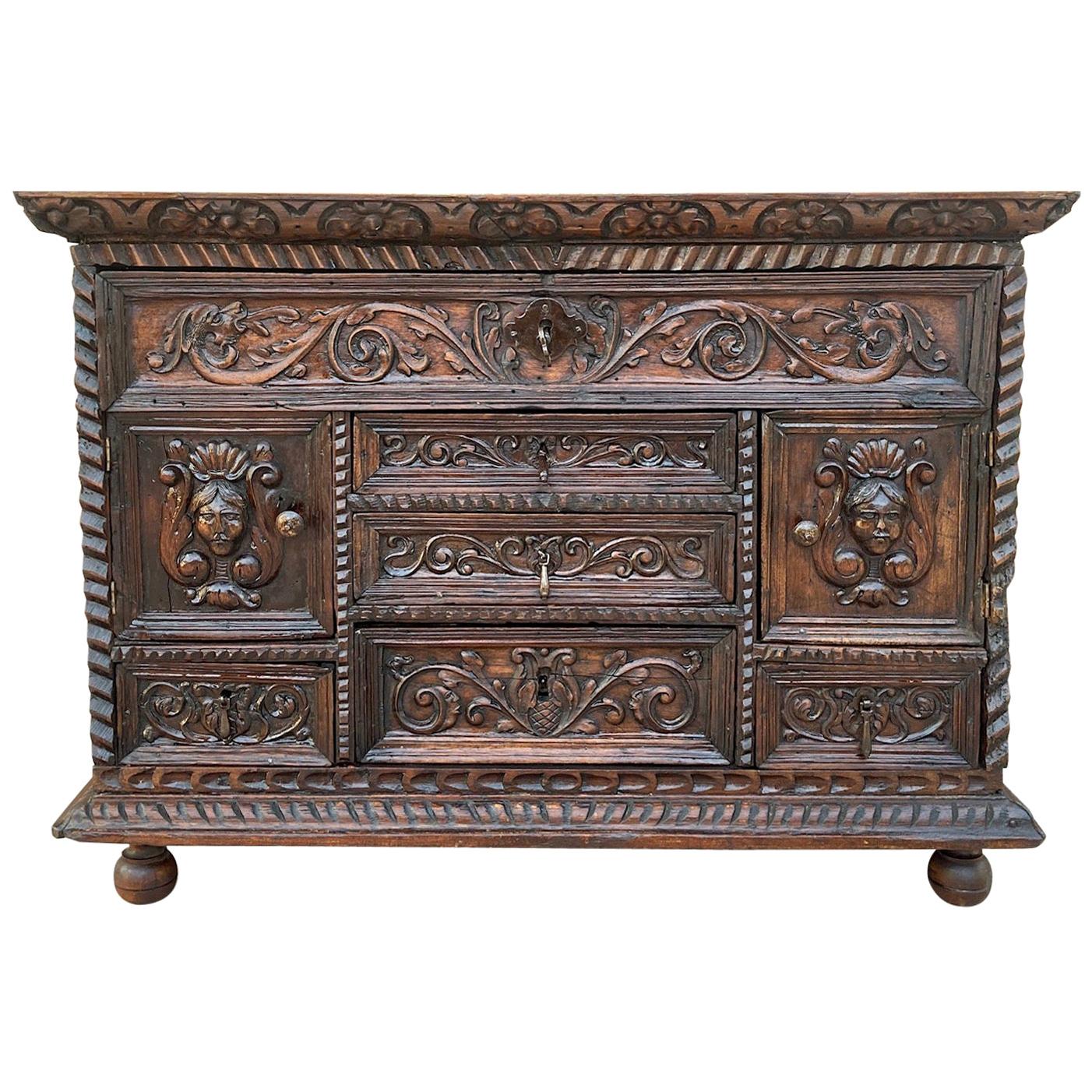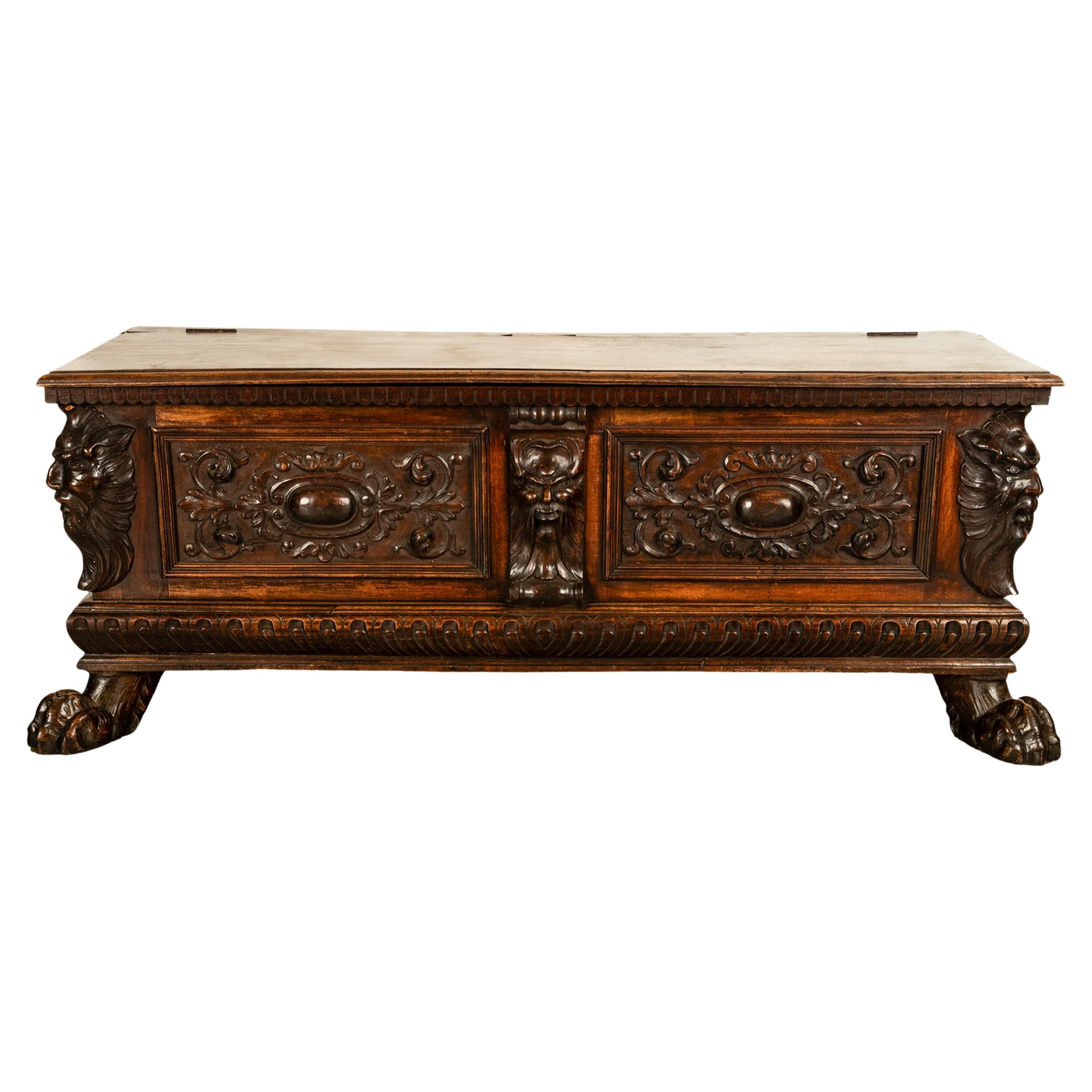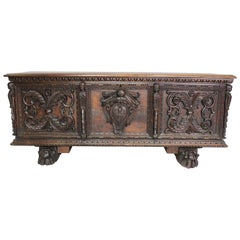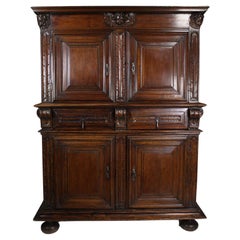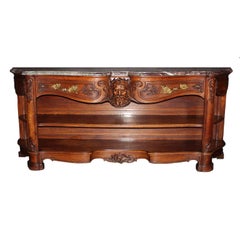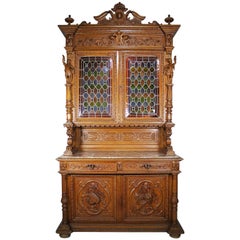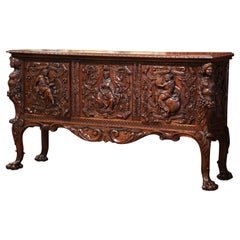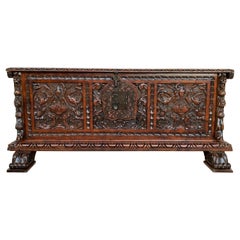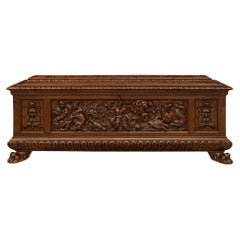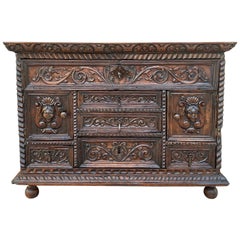Items Similar to Italian 19th Century Carved Walnut Cassone Chest with Putti and Winged Dragons
Want more images or videos?
Request additional images or videos from the seller
1 of 21
Italian 19th Century Carved Walnut Cassone Chest with Putti and Winged Dragons
$46,850
$64,85027% Off
£35,242.43
£48,782.7527% Off
€40,826.73
€56,512.5627% Off
CA$66,048.80
CA$91,425.0827% Off
A$73,450.67
A$101,670.7827% Off
CHF 38,551.78
CHF 53,363.5627% Off
MX$895,695.63
MX$1,239,826.2927% Off
NOK 487,218.09
NOK 674,409.6827% Off
SEK 456,786.38
SEK 632,285.9427% Off
DKK 304,725.75
DKK 421,802.8827% Off
About the Item
A Fine and Large Italian Florentine 19th Century Baroque Revival Style Carved Walnut Figural Cassone Chest on Stand. The ornately carved drop-front cassone with an allegorical in-relief carvings depicting playful Putti among satyrs, fruits and acorns, centered with a carved winged lion holding a shield, flanked on each side by pull-out drawer compartments, each with carvings of a single Putto. The swagged apron centered with carvings depicting two Putti resting on an allegorical male mask crowned with fruits and flanked by floral wreaths, ribbons and seashells, all raised with a pair of resting winged dragons. Circa: Florence, 1880-1890.
A cassone (plural cassoni) or marriage chest is a rich and showy Italian type of chest, which may be inlaid or carved, prepared with gesso ground then painted and gilded. Pastiglia was decoration in low relief carved or moulded in gesso, and was very widely used. The cassone ("large chest") was one of the trophy furnishings of rich merchants and aristocrats in Italian culture, from the Late Middle Ages onward. The cassone was the most important piece of furniture of that time. It was given to a bride and placed in the bridal suite. It would be given to the bride during the wedding, and it was the bride's parents' contribution to the wedding.
There are in fact a variety of different terms used in contemporary records for chests, and the attempts by modern scholars to distinguish between them remain speculative, and all decorated chests are today usually called cassoni, which was probably not the case at the time. For example, a forziere probably denoted a decorated chest with a lock.
Since a cassone contained the personal goods of the bride, it was a natural vehicle for painted decoration commemorating the marriage in heraldry and, when figural painted panels began to be included in the decor from the early quattrocento, flattering allegory. The side panels offered a flat surface for a suitable painting, with subjects drawn from courtly romance or, much less often, religious subjects. By the 15th century subjects from classical mythology or history became the most popular. Great Florentine artists of the 15th century were called upon to decorate cassoni, though as Vasari complains, by his time in the 16th century, artists thought such work beneath them. Some Tuscan artists in Siena and Florence specialized in such cassone panels, which were preserved as autonomous works of art by 19th century collectors and dealers, who sometimes discarded the cassone itself. From the late 1850s, neo-Renaissance cassoni were confected for dealers like William Blundell Spence, Stefano Bardini or Elia Volpi in order to present surviving cassone panels to clients in a more "authentic" and glamorous presentation.
A typical place for such a cassone was in a chamber at the foot of a bed that was enclosed in curtains. Such a situation is a familiar setting for depictions of the Annunciation or the Visitation of St. Anne to the Virgin Mary. A cassone was largely immovable. In a culture where chairs were reserved for important personages, often pillows scattered upon the floor of a chamber provided informal seating, and a cassone could provide both a backrest and a table surface. The symbolic "humility" that modern scholars read into Annunciations where the Virgin sits reading upon the floor, perhaps underestimates this familiar mode of seating.
At the end of the 15th century, a new classicising style arose, and early Renaissance cassoni of central and northern Italy were carved and partly gilded, and given classical décor, with panels flanked by fluted corner pilasters, under friezes and cornices, or with sculptural panels in high or low relief. Some early to mid-sixteenth-century cassoni drew their inspiration from Roman sarcophagi (illustration, right). By the mid-sixteenth century Giorgio Vasari could remark on the old-fashioned cassoni with painted scenes, examples of which could be seen in the palazzi of Florentine families.
A cassone that has been provided with a high panelled back and sometimes a footrest, for both hieratic and practical reasons, becomes a cassapanca ("chest-bench"). Cassapanche were immovably fixed in the main public room of a palazzo, the sala or salone. They were part of the immobili ("unmoveables"), perhaps even more than the removable glazed window casements, and might be left in place, even if the palazzo passed to another family.
A similar Cassone, most likely by the same Florentine cabinetmaker, was acquired in Florence in the 1880's by Grand Duke Vladimir Alexandrovich, the younger brother of the Emperor Alexander III of Russia. The Cassone is currently on display in the Vladimir Palace (the former official residence of GD Vladimir Alexandrovich) in St.Petersburg, Russia. An image of the Cassone at The Vladimir Palace is available upon request.
Jan's & Co. Fine French Antiques, Inc. would like to thank Nadia Smotkin in St. Petersburg, Russia, for providing us with this information.
Overall height: 52 1/8 inches (132.4 cm)
Overall width: 83 1/2 inches (212.1 cm)
Overall depth: 29 3/4 inches (75.6 cm)
- Dimensions:Height: 52.13 in (132.42 cm)Width: 83.5 in (212.09 cm)Depth: 29.75 in (75.57 cm)
- Style:Baroque Revival (In the Style Of)
- Materials and Techniques:
- Place of Origin:
- Period:
- Date of Manufacture:Circa: Florence, 1880-1890
- Condition:Repaired: Minor old touch ups and carving restorations. Wear consistent with age and use. Minor losses. Minor fading. A truly stunning carved cassone chest. Overall condition is very good with some age wear, minor carving losses/restorations, minor wood stress and fading. One key.
- Seller Location:Los Angeles, CA
- Reference Number:Seller: Ref.: A2726 - Lot 119681stDibs: LU1796237092312
About the Seller
5.0
Vetted Professional Seller
Every seller passes strict standards for authenticity and reliability
Established in 1982
1stDibs seller since 2016
134 sales on 1stDibs
Typical response time: 1 hour
- ShippingRetrieving quote...Shipping from: Los Angeles, CA
- Return Policy
Authenticity Guarantee
In the unlikely event there’s an issue with an item’s authenticity, contact us within 1 year for a full refund. DetailsMoney-Back Guarantee
If your item is not as described, is damaged in transit, or does not arrive, contact us within 7 days for a full refund. Details24-Hour Cancellation
You have a 24-hour grace period in which to reconsider your purchase, with no questions asked.Vetted Professional Sellers
Our world-class sellers must adhere to strict standards for service and quality, maintaining the integrity of our listings.Price-Match Guarantee
If you find that a seller listed the same item for a lower price elsewhere, we’ll match it.Trusted Global Delivery
Our best-in-class carrier network provides specialized shipping options worldwide, including custom delivery.More From This Seller
View AllItalian 19th Century Baroque Style Carved Walnut Figural Cassone Chest-Trunk
Located in Los Angeles, CA
An Italian 19th century Baroque Revival style carved walnut figural Cassone chest-trunk. The ornately carved chest, also known as a marriage chest, with ...
Category
Antique 19th Century Italian Baroque Revival Commodes and Chests of Drawers
Materials
Wrought Iron
$5,950 Sale Price
52% Off
A 17th-18th Century French/Italian Renaissance Walnut Carved Credenza Cabinet
Located in Los Angeles, CA
A 17th-18th Century French/Italian Renaissance Walnut Figural Carved Credenza Cabinet or Cupboard. The two-part cabinet with a pair of upper coffered doors with metal key-hole hardwa...
Category
Antique Late 17th Century Renaissance Cabinets
Materials
Metal
French Baroque 19th Century Louis XV Style Finely Carved Walnut Buffet Console
Located in Los Angeles, CA
French Baroque 19th century Louis XV style finely carved walnut figural buffet server console with a variegated Rouge Royal marble top, the apron centered with a relief carved figure...
Category
Antique 19th Century French Baroque Revival Console Tables
Materials
Marble, Bronze
$34,850 Sale Price
26% Off
Large Italian 19th Century Baroque Style Oak-Carved Figural Credenza Cabinet
Located in Los Angeles, CA
A fine and rare Italian 19th century Baroque style oak-carved figural credenza cabinet. The upper part with a pair of colorful Vitreaux (Stained glass) panelled doors, surmounted on ...
Category
Antique 19th Century Italian Baroque Revival Buffets
Materials
Marble
$21,850 Sale Price
20% Off
French 19th Century Louis XIV Style Baroque Figural Carved Walnut Two-Door Vitri
Located in Los Angeles, CA
A Fine French 19th Century Louis XIV Style Baroque Revival Figural Carved Walnut Two-Door Vitrine. The finely carved body, crowned with a pair of male busts, the doors with symmetric...
Category
Antique Late 19th Century French Baroque Revival Vitrines
Materials
Glass, Walnut
Large Italian Early 20th Century Gildwood Carved Server Buffet with Marble Top
Located in Los Angeles, CA
A fine and large Italian early 20th century gildwood carved and gilt-brass mounted server buffet with marble top. The rectangular fruit wood body with four front doors ornately carve...
Category
Antique Early 1900s Italian Belle Époque Buffets
Materials
Marble
$14,850 Sale Price
40% Off
You May Also Like
Mid-19th Century Italian Renaissance Hand Carved Walnut Credenza Cabinet
Located in Dallas, TX
This heavily carved credenza was created in Italy circa 1870. Built of solid walnut, the buffet stands on elegant cabriole legs decorated with acanthus leaves at the shoulders, and ending with paw feet. The cabinet features three doors across the front opening to inside shelving for ultimate storage, over a scalloped apron. The buffet is richly carved throughout with high relief female figures in the corners, carved females on each door, scroll motifs and floral vase arrangements on both side panels. The Renaissance style sideboard...
Category
Antique Mid-19th Century Italian Renaissance Credenzas
Materials
Walnut
Catalan Baroque Carved Walnut Cassone or Trunk, 18th Century
Located in Miami, FL
Catalan Baroque carved walnut cassone or trunk, 18th century.
Category
Antique Late 18th Century Spanish Baroque Blanket Chests
Materials
Iron
Italian late 16th century Baroque period Walnut Cassone
Located in West Palm Beach, FL
A very handsome and high quality Italian late 16th century Baroque period Walnut Cassone. This exceptional Cassone is of museum quality with the phenomenal detailing and attention to...
Category
Antique 16th Century Italian Commodes and Chests of Drawers
Materials
Walnut
Spanish Renaissance Carved Walnut Cassone or Trunk, 19th Century
Located in Miami, FL
This piece it´s part of a bargueño without legs, this carved walnut pieces you can use like a cassone, trunk or coffee table, 19th century.
Category
Antique Late 19th Century Spanish Baroque Blanket Chests
Materials
Walnut
Antique Italian Renaissance Carved Walnut Cassone Chest Window Seat 1850
Located in Portland, OR
A good antique 19th century Italian Renaissance Revival carved walnut cassone chest, circa 1850.
The chest having a lift up hinged lid with a carved scalloped molding below, the hing...
Category
Antique 1850s Italian Renaissance Revival Blanket Chests
Materials
Walnut
Continental Carved Walnut Chest
Located in Vista, CA
A continental carved walnut chest in the Renaissance taste, 18th century, probably Italian, the lid opens to a void interior. The case is carved wi...
Category
Antique 18th Century Italian Renaissance Blanket Chests
Materials
Walnut
More Ways To Browse
With Crown Carved
Furniture With Carved Ribbons
Used Casement Window
Antique Ribbon Case
Lion And Crown
Used Cabinet Bed
Carved Wreath
Italian Putti
Putti Carved
Antique Ribbon Cabinet
Antique St Petersburg Russia
Used Casement Windows
Putti Figure
Acorn Carved
Dragon Italy
Antique End Tables With Storage
Antique Casement Windows
Wedding Cabinet
